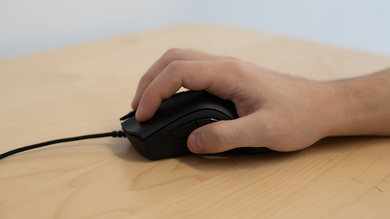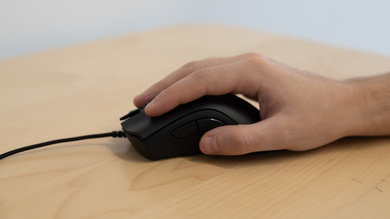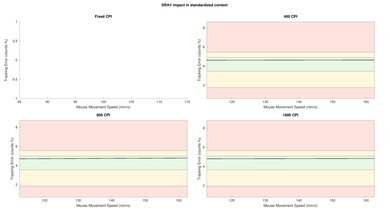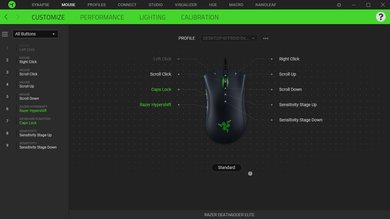The Razer DeathAdder Elite is a very good gaming mouse that follows the DeathAdder design from previous years. It's great for right-handed people who are looking for a mouse with amazing performance and setting options. It has a sleek gaming design, without overdoing it, and fits almost every hand size and grip. Unfortunately, people with smaller hands might have an awkward hand posture when using the claw or fingertip grip. Nevertheless, this wired mouse has low latency, which is great for gamers but the cable is quite rigid.
Our Verdict
Good to use as an office mouse. It has a nice ergonomic shape for right-handed people and offers a few customizable buttons. It might not be ideal for smaller hands if you use claw or fingertip grip, but it'll be fine for palm grip. This mouse is also wired-only, so you'll have to route its cable so it doesn't bother you on your desk.
-
Very good for gaming.
-
Excellent performance.
-
Very well-built design.
-
Almost universal for all hand sizes and grips.
-
Not recommended for smaller hands, unless using palm grip.
-
Rigid cable.
-
Not suitable for traveling due to wired-only use and size.
Very good for video games like FPS. It has amazing performance and can be customized to suit your preferences, but it isn't the lightest option. On the upside, its click latency is decently low and the mouse feels responsive. It also has a few programmable buttons, which is good. It's also suitable for most hand sizes, although people with small hands might feel like their hand posture is awkward when using the claw or fingertip grip.
-
Very good for gaming.
-
Excellent performance.
-
Very well-built design.
-
Almost universal for all hand sizes and grips.
-
Not recommended for smaller hands, unless using palm grip.
-
Rigid cable.
-
Not suitable for traveling due to wired-only use and size.
Very good for MMO games. It has a few programmable buttons, but not as many as MMO mice with a side panel filled with extra buttons. It might also be too big for small hands if you're using the claw or fingertip grip, but otherwise, this mouse is pretty universal for most right-handed people. Its wired design allows very low latency, which is good for gaming.
-
Very good for gaming.
-
Excellent performance.
-
Very well-built design.
-
Almost universal for all hand sizes and grips.
-
Not recommended for smaller hands, unless using palm grip.
-
Rigid cable.
-
Not suitable for traveling due to wired-only use and size.
Decent for ultra-light gaming. This mouse's performance is excellent, but it's just under 100g if you elevate the cable with a bungee. This is noticeably higher than ultra-lightweight gaming mice, but isn't too heavy. The wired latency is low and the mouse is suitable for almost any hand size and grip, other than smaller hands with a claw or fingertip grip.
-
Very good for gaming.
-
Excellent performance.
-
Very well-built design.
-
Almost universal for all hand sizes and grips.
-
Not recommended for smaller hands, unless using palm grip.
-
Rigid cable.
-
Not suitable for traveling due to wired-only use and size.
Not recommended for traveling. It's quite bulky and wired-only. This won't be great for using on the train or a plane with a laptop.
-
Very good for gaming.
-
Excellent performance.
-
Very well-built design.
-
Almost universal for all hand sizes and grips.
-
Not recommended for smaller hands, unless using palm grip.
-
Rigid cable.
-
Not suitable for traveling due to wired-only use and size.
- 7.2 Office/Multimedia
- 7.5 Video Games (FPS)
- 7.1 Video Games (MMO)
- 6.8 Ultra-Light Gaming
- 4.7 Travel
Changelog
- Updated Sep 28, 2022: We've converted this review to Test Bench 1.2. This update simplifies our Weight test and expands on our CPI test from Test Bench 1.1, resulting in changes to test results in both sections. For more details, you can see our complete changelog here.
- Updated Sep 21, 2022: We've converted this review to Test Bench 1.1. This update revamps our Click Latency test and results in changes to test results. For more details, you can see our full changelog here.
- Updated Oct 05, 2020: Converted to Test Bench 1.0.
- Updated Dec 20, 2019: Converted to Test Bench 0.8.1.
- Updated Dec 11, 2019: Review published.
Check Price
Compared To Other Mice
The Razer DeathAdder Elite is a very good gaming mouse. It's a popular model that's also available for left-handed people, although it's the regular DeathAdder and not the Elite version. It has a very good build quality, amazing performance, and is amazing with a palm grip. Unfortunately, its cable is similar to most Razer mice, which is quite stiff and annoying. See our recommendations for the best wired mouse, the best gaming mouse, and the best mouse. If you're interested in Razer products, also check out the best Razer mice.
The Razer Mamba Elite and Razer DeathAdder Elite are very similar wired gaming mice. They're both right-handed mice that are good for all hand sizes with palm grip and all hand sizes except small for both claw and fingertip grip. The DeathAdder Elite's CPI is adjustable by increments of 1, which is outstanding and helps you precisely fine-tune its performance for your preference. On the other hand, the Mamba Elite has two more programmable buttons, as well as on-board memory, so you can maintain your settings if you switch PCs.
The Logitech G502 HERO is a larger gaming mouse than the Razer DeathAdder Elite and will be tougher for people with small hands to grip comfortably. While both mice are wired-only, the Logitech has a higher-quality cable that is more flexible. The Logitech also has more programmable buttons, a much better scroll wheel with L/R tilt, and an unlock button for free scrolling.
The Razer Viper is overall a better mouse than the Razer DeathAdder Elite, but the DeathAdder Elite might be a better choice if you're a palm grip user. The Viper has an ambidextrous design with two side buttons on each side, which gives it slightly more programmable buttons. It also has a much lower click latency and a lighter weight. However, the DeathAdder Elite has a comfortable right-handed slant, and its CPI range can be adjusted extremely precisely by increments of one.
The Razer DeathAdder V2 is a better mouse than the Razer DeathAdder Elite. It's lighter, has a much less stiff and rigid cable, a better sensor, and on-board memory, so you can save your customization settings to the mouse and keep them if you switch PCs. On the other hand, the DeathAdder Elite can often be found much cheaper.
The Razer Viper Mini is a slightly better gaming mouse than the Razer DeathAdder Elite. The Mini is very lightweight and feels well-built and comfortable, though larger hands may have difficulty using it with a palm or a claw grip. It has better feet, a more flexible cable, and a much lower click latency. That said, the Elite has a wider CPI range that you can adjust very precisely, and that’s more consistent. It also has a lower lift-off distance. It should be a better fit for larger hands using any grip type, while smaller hands may have difficulty using it with a claw or a fingertip grip.
The Logitech G Pro Wireless is a more versatile gaming mouse than the Razer DeathAdder Elite as it can be used both wired or wireless, with very low latency either way. The Logitech is also lighter than the Razer and is more suitable for small hands when using a claw grip. However, some people may prefer the more slanted shape of the Razer instead of the Logitech's more typical and straight design.
The Razer DeathAdder Elite and the Logitech G305 LIGHTSPEED are both very good gaming mice. The Logitech is wireless, while the Razer is wired. Both have similar weight and two programmable side buttons. Due to its smaller size, the Logitech may be more suitable for people with small hands, especially in a claw or fingertip grip. On the other hand, some may prefer the more comfortable, slanted shape of the Razer.
The Razer Basilisk is slightly heavier than the Razer DeathAdder Elite and has a different shape. While they're both designed for right-handed use, the Basilisk has a thumb rest on its left side. They both are suitable for every hand size in every grip type, except small hands for claw or fingertip. The latency of both mice is very low, though the Basilisk is a little lower. The Basilisk also has one more programmable button than the Elite and on-board memory, so you can maintain your customization settings if you switch PCs.
The Razer DeathAdder Elite and the Razer DeathAdder Essential have the same shape and size, but the Elite performs better overall. It has a much wider CPI range, and its CPI can be adjusted much more precisely in increments of one. Also, its minimum lift-off distance is lower, and it has two programmable buttons below its scroll wheel, which the Essential lacks.
The Razer DeathAdder V2 Pro is in the same family as the Razer DeathAdder Elite, but it’s more recent and performs better overall. The Pro has wireless connectivity, and you can pair it with up to two devices at once. Compared to the Elite, it’s slightly lighter, has a better cable, and a significantly lower click latency. However, the Elite, which is wired-only, lets you adjust its CPI much more precisely and has a lower lift-off distance.
The GLORIOUS Model D is a better gaming mouse than the Razer DeathAdder Elite. It's noticeably lighter and has one of the best cables we've tested. The Razer feels a bit better built, but the cable can keep many kinks from packaging and creates drag when moving the mouse.
The Razer DeathAdder Elite is better than the BenQ ZOWIE EC2. The Razer feels better built, more comfortable, and has RGB lighting on its scroll wheel and logo. Also, the Razer has a much wider CPI range that you can adjust very precisely, and it comes with software for customizations. However, the BenQ has a lower click latency.
The Razer DeathAdder Elite and the Razer Mamba Wireless are both very good gaming mice. The Mamba doesn't require a cable but still has lower click latency than the Elite, even when used with its USB receiver. The Mamba also has onboard memory to save your settings to the mouse. Both mice perform very similarly, but the Elite's CPI can be adjusted by increments of 1, allowing you to fine-tune it to your preferences.
The Razer DeathAdder Elite and the GLORIOUS Model O are both great wired gaming mice. The GLORIOUS is quite a bit lighter and has a much better cable than the Razer. However, the mouse is a bit bigger and may not be well-suited for people with smaller hands. Both mice have low latency and a customizable CPI, though the Razer has a wide range of CPI options and can be set with increments of 1, which is great.
The Logitech G402 Hyperion Fury is better than the Razer DeathAdder Elite. The Logitech has a better build quality, lower click latency, and Logitech's G HUB works with both Windows and macOS. However, the Razer is lighter, more comfortable to use, and you can adjust the sensitivity in smaller increments.
The Razer DeathAdder Elite and the Corsair M55 RGB Pro are very similar mice, but the Razer has better overall performance due to the Corsair's inconsistent sensor sensitivity. The Razer's shape and size are also better suited for a wider variety of hand sizes and grips due to its right-slanted design. Its lift-off distance is also noticeably lower. On the other hand, the Corsair will be a better option if you want to use your mouse left-handed, and it has more inputs thanks to two side buttons on each side of the mouse.
The Razer Viper Ultimate is a better gaming mouse than the Razer DeathAdder Elite. Its wireless design gets rid of the clutter of a cable, and it's also noticeably lighter. Its click latency is lower and, when used wired, its cable is lighter than the Elite's. On the other hand, the Elite has a right-slanted design and is slightly better for people with larger hands.
The Razer DeathAdder Elite and the Razer DeathAdder V2 Mini are both very good gaming mice. The Mini has a lower click latency, and it's much lighter than the Elite, thanks to its smaller size. However, the Elite has more programmable buttons, a more adjustable and consistent sensor, and its larger size makes it better suited for large and extra-large hands. However, the Elite doesn't have on-board memory like the Mini does.
The SteelSeries Rival 3 and the Razer DeathAdder Elite are comparable wired gaming mice, and each has its advantages and disadvantages. The SteelSeries is significantly lighter, has a somewhat lower click latency, and its software is compatible with both Windows and macOS. It's suitable for all grip types, but it's ideal for a claw grip, regardless of hand size. On the other hand, the Razer has a wider CPI range, and you can set the CPI by increments of one. It also has a lower lift-off distance and larger side buttons. It's well-suited for a palm grip for all hand sizes, but those with smaller hands likely won't be able to use the mouse comfortably with a claw or fingertip grip.
The Razer DeathAdder Elite and the Razer Basilisk Essential are both gaming mice, but the Elite has a much wider CPI range, a CPI that you can adjust very precisely in increments of one, a lower lift-off distance, and much lower click latency. On the other hand, the Essential has a dedicated sniper button and a thumb rest. Both are best-suited for larger hands, although people with small hands may be comfortable with a palm grip.
The Razer DeathAdder Elite and the Microsoft Pro IntelliMouse are gaming mice with similar ergonomic shapes and comparable performance. The Razer is lighter, has a lower minimum CPI, and a more precisely adjustable CPI. Comparatively, the Microsoft has onboard memory, which the Razer lacks. Both mice are well-suited for larger hands and all grip types, though the Razer is also well-suited for smaller hands using a palm grip.
Overall, the Logitech G403 HERO is better than the Razer DeathAdder Elite. The Logitech is slightly lighter, has lower click latency, and full compatibility with Windows and macOS. However, the Razer has more programmable inputs, better build quality, and it allows you to adjust the sensitivity in smaller increments.
Overall, the Logitech G PRO HERO is much better than the Razer DeathAdder Elite. The Logitech is lighter, better-built, and has much lower click latency. However, the Razer is more comfortable to use, and it allows you to adjust the sensitivity in smaller increments.
The Razer DeathAdder Elite and the Logitech G502 Proteus Spectrum are good, wired gaming mice with several noteworthy differences. The Razer is significantly lighter and has a lower lift-off distance. It also has a wider CPI range, less CPI variation, and you can precisely adjust the set CPI by increments of one. Its companion software is only compatible with Windows, but it has onboard memory for custom settings. It's well-suited for all grip types, but those with small hands may find the mouse is a little too long for a comfortable claw or fingertip grip. The Logitech has significantly lower latency, one additional side button, and more total programmable buttons. It also has companion software that's compatible with Windows and macOS. It's well-suited to all grip types, but only for larger hands.
The Razer DeathAdder Elite and the Corsair GLAIVE PRO are both great wired gaming mice. The Razer weighs less, has more programmable buttons, and a lower lift-off distance. On the other hand, the Corsair has a wider CPI range, a lower click latency, and is fully compatible with Windows and macOS. The Corsair is better suited for claw grip for all hand sizes, while the Razer is best for all hand sizes with a palm grip.
The Razer DeathAdder Elite and the Corsair M65 PRO RGB are comparable FPS gaming mice. The Razer is much lighter, has smoother-gliding mouse feet, and a higher maximum CPI. Unfortunately, its software is only compatible with Windows. On the other hand, the Corsair feels much sturdier, has an extra side button, a lower click latency, onboard memory, and software compatible with Windows and macOS. Both mice are well-suited for all grip types, though the Razer is better suited for larger hands, while the Corsair is a bit better suited for smaller hands.
The Mountain Makalu 67 is an excellent ultra-lightweight gaming mouse, while the Razer DeathAdder Elite is a very good wired gaming mouse. The Mountain is significantly lighter and feels sturdier. It has a more flexible cable and mouse feet that glide more smoothly. Performance-wise, it has a wider CPI range and lower click latency. It also has onboard memory, which the Razer lacks. On the other hand, the Razer allows you to adjust your CPI more precisely, and you can set a HyperShift button to enable a secondary layer of commands. Both mice are well-suited for all grip types, but neither mouse is very well-suited for small hands.
The Razer DeathAdder Elite is a better wired mouse for FPS gaming than the SteelSeries Rival 710. The Razer is much lighter and is better suited for people with small hands. Its CPI range is also more consistent and easier to fine-tune as you can adjust it by increments of 1. On the other hand, the SteelSeries feels a bit more comfortable, and its companion software is fully compatible with macOS and Windows, as opposed to Razer's Synapse 3, which is only compatible with Windows.
The Razer DeathAdder Elite is a bit better than the Corsair HARPOON RGB. The Razer can be used by most grip types and hand sizes, except small hands with a claw or fingertip grip. It has a significantly better sensor with a much wider CPI range, and you can adjust the CPI by increments of one. It also has more programmable inputs. However, the Corsair's dedicated software is also available on macOS, and the mouse is lighter.
The SteelSeries Rival 310 and the Razer DeathAdder Elite are both great wired FPS gaming mice. The Razer has a wider CPI range that you can fine-tune by increments of 1, which is excellent. Also, it has a more consistent sensor and lower lift-off distance. On the other hand, the Rival 310 has a slightly lower click latency and is fully compatible with both Windows and macOS, while the Razer is only partially compatible with macOS.
The Razer DeathAdder Elite is a better wired gaming mouse than the ROCCAT Tyon. The Razer is much lighter, and its slightly smaller body is better suited for small hands if you use a palm grip. It also has a much wider adjustable CPI range. On the other hand, the ROCCAT has way more programmable buttons.
The Razer DeathAdder Elite is a better-performing mouse than the Logitech M510. The Logitech is wireless, which might be better for people looking for a straightforward wireless mouse for the office. The DeathAdder is more geared towards gaming and features full RGB lighting and excellent sensor performance.
The Razer DeathAdder Elite is a slightly better gaming mouse than the Dell Alienware AW610M. It feels better built, can be used in all grip types with all but small hands, and has much lower latency. On the other hand, the AW610M can be used wired or wireless and has more RGB lighting.
The Logitech G203 Prodigy and the Razer DeathAdder Elite are both great wired gaming mice. While the Logitech is ambidextrous, the Razer is designed for right-handed use. The Logitech is also better for smaller hands for all grip types, though larger hands can get a more comfortable grip with the Razer. They both have low latency and a wide range of customizable CPI, but the Razer has more programmable buttons.
The Razer Naga Trinity and the Razer DeathAdder Elite are both great gaming mice, but for different purposes. The Trinity has three optional side panels to give you your choice of a more standard 2-button layout, a more MMO-centric layout with 12 more buttons, or a circular 6-button layout. They're both designed for right-handed use, though the Elite will be better in palm grip for small or extra-large hands as the Trinity is quite a bit wider and has a palm rest on the right side.
The SteelSeries Rival 600 and the Razer DeathAdder Elite are both great wired gaming mice. They feel equally well-made and are both designed for right-handed use. The Razer is better for people with small hands, as you can use it comfortably in a palm grip with any hand size. The SteelSeries will be hard to get a comfortable hold with any grip for people with small hands. You can adjust the Razer's CPI in increments of 1, which is outstanding, while the SteelSeries uses increments of 100.
The Corsair SCIMITAR PRO RGB is designed for MMOs thanks to its plethora of programmable side buttons. On the other hand, the Razer DeathAdder Elite is more of an FPS mouse as it's much lighter weight, has lower latency, and two side buttons. Both mice aren't recommended for small hands if using fingertip grip, and the Razer may not be great for small hands in the claw grip as well.
Test Results
The Razer DeathAdder Elite looks like a gaming mouse, but without having a futuristic look. It's fairly simple and sleek, with the Razer logo on the back. Unlike the Razer DeathAdder Essential, which only has green lighting, the Elite has RGB lighting on both the logo and on each side of the mouse wheel. It has a slight downward slant on the right side, too. There are also some Overwatch, Destiny 2, and SKT T1 special editions.
The Razer DeathAdder Elite is a very well-built gaming mouse. It's made of solid plastic and there are no wobbling parts. The mouse feels a bit less loose than the Mamba Elite since the DeathAdder doesn't have the ability to tilt its mouse wheel, but this is a very minor difference. Its feet are fairly good and glide well.
There isn't any weight optimization with this mouse. It still feels decently light, but isn't as light as some ultra-lightweight gaming mice. If you want a lighter mouse, look into the Corsair HARPOON RGB.
This mouse's ergonomics are very good for right-handed people. There are latex grips on the side to help grab the mouse firmly and it's quite easy to reach all the buttons, too. It's a fairly long mouse, so it's more suitable for palm and claw grip, but you can also use the fingertip grip if you don't have smaller hands. For a true ambidextrous design with side buttons on both sides, check out the Corsair M55 RGB Pro or the SteelSeries Sensei 310. If you want a non-slanted design with a lower back hump, check out the Razer Viper. If you're interested in a mouse with similar performance but with an internal fan intended to keep your hand cool and dry, take a look at the Marsback Zephyr RGB.
Note: There isn't a left-handed version of this mouse, but there is one for the regular DeathAdder.
The Razer DeathAdder Elite is a wired-only mouse. If you want a wireless mouse that still performs great, check out the Razer Mamba Wireless.
The DeathAdder Elite has a typical braided Razer cable. Just like the Naga Trinity's, this mouse's cable is rigid and not very flexible. The cable maintains a lot of kinks, which can be bothersome when using the mouse. If you want something with a much better cable, check out the Razer DeathAdder V2, as it uses Razer's new cable which is much less rigid and stiff.
The Razer DeathAdder Elite doesn't have as many programmable buttons as MMO mice, but still has enough for most gamers. You can also reprogram pretty much any button, including scroll up and down. For a similar but wireless mouse that has CPI buttons on the edge of its left click, check out the Razer DeathAdder V2 X HyperSpeed.
The Razer DeathAdder Elite's wired click latency is good, and most people will be satisfied with it. You won't notice any delay when gaming with it. If you want a mouse with even lower click latency, check out the XTRFY M4 RGB.
The Razer Synapse 3 is fairly good software, but the options with the DeathAdder Elite are quite sub-par. The mouse doesn't have onboard memory, so you won't be able to use it with multiple computers, but this might not be an issue for most gamers that only have a single setup. Unfortunately, you can't save multiple profiles and switch between them. There are also a few more features if you do create an account, like saving your settings and lighting patterns for all Razer products.
Excellent compatibility. Although the Razer Synapse 3 software isn't available on macOS, you can still use the Razer DeathAdder Elite on both Windows and macOS. You won't be able to customize your settings on macOS, but other than that, all the default buttons and settings work with it. Check out the similar SteelSeries Rival 710 if you need full macOS compatibility.
Comments
Razer DeathAdder Elite: Main Discussion
Let us know why you want us to review the product here, or encourage others to vote for this product.

































